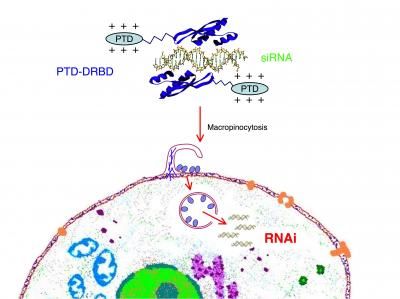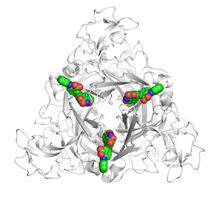Nanomedical approach targets multiple cancer genes, shrinks tumors more effectively
Advertisement
nanoparticles filled with a drug that targets two genes that trigger melanoma could offer a potential cure for this deadly disease, according to cancer researchers. The treatment, administered through an ultrasound device, demonstrates a safer and more effective way of targeting cancer-causing genes in cancer cells without harming normal tissue.
"It is a very selective and targeted approach," said Gavin Robertson, associate professor of pharmacology, pathology and dermatology, Penn State College of Medicine. "And unlike most other cancer drugs that inadvertently affect a bunch of proteins, we are able to knock out single genes."
The Penn State researchers speculated that "silencing RNA" (siRNA) - strands of RNA molecules that knock out specific genes - could turn off the two cancer-causing genes and potentially treat the deadly disease more effectively.
"siRNA checks the expression of the two genes, which then lowers the abnormal levels of the cancer causing proteins in cells," explained Robertson, who is lead author of the paper appearing in Cancer Research.
In recent years, researchers have zeroed in on two key genes - B-Raf and Akt3 - that cause melanoma. B-Raf, the most frequently mutated gene in melanoma, produces the mutant protein, B-Raf, which helps mole cells survive and grow but does not form melanomas on its own. Robertson and colleagues previously found that a protein called Akt3 regulates the activity of the mutated B-R af, which aids the development of melanoma.The drug in this study specifically targets Akt3 and the mutant B-Raf and does therefore not affect normal cells, added Robertson, who is also director of the Foreman Foundation Melanoma Therapeutics Program at the Penn State College of Medicine Cancer Institute.
However, while knocking out specific genes may seem like a straightforward task, delivering the siRNA drug to cancerous cells is another story, because protective layers in the skin not only keep drugs out, but chemicals in the skin quickly degrade the siRNA. To clear these two hurdles, Robertson and his team engineered hollow nano-sized particles - nanoliposomes - from globes of fatty acids into which they packed the siRNA. Next, the researchers used a portable ultrasound device to temporarily create microscopic holes in the surface of the skin, allowing the drug-filled particles to leak into tumor cells beneath.
"Think of it as tiny basketballs that each protect the siRNA inside from getting degraded by the skin," explained Robertson. "These basketballs fall through the holes created by the ultrasound and are taken up by the tumor cells, thereby delivering the siRNA drug into the tumor cells."
When the researchers exposed lab-generated skin - made from human connective tissue - containing early cancerous lesions to the treatment 10 days after the skin was created, the siRNA reduced the ability of cells containing the mutant B-Raf to multiply by nearly 60 to 70 percent, and more than halved the size of lesions after three weeks. Mice with melanoma that underwent the same treatment had their tumors shrink by nearly 30 percent when only the mutant B-Raf was targeted. There was no difference in the development of melanoma when the Akt3 gene alone was targeted, though existing tumors shrank by about 10 to 15 percent in two weeks. However, when the researchers targeted both the Akt3 and the mutant B-Raf at the same time, they found that tumors in the mice shrank about 60 to 70 percent more than when either gene was targeted alone.
While human clinical trials could be years away, Robertson says the findings show the promise of personalized medicine, where patients could receive treatments designed to specifically target the errant genes or proteins for their disease.

















































